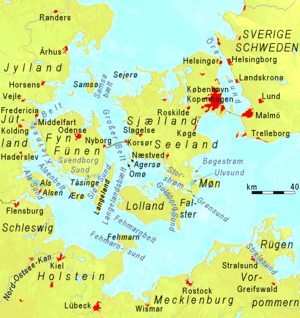Baltimax
 The Danish islands and straits, which limit the Baltimax ship size | |
| General characteristics | |
|---|---|
| Tonnage: | 100,000 DWT..205,000 DWT |
| Length: | 240 m (787 ft)..400 m (1,312 ft) |
| Beam: | 42 m (138 ft)..68 m (223 ft) |
| Height: | 65 m (213 ft) |
| Draft: | 15.4 m (51 ft) |
Baltimax is a naval architecture term for the largest ship measurements capable of entering and leaving the Baltic Sea in a laden condition.
It is the Great Belt route that allows the largest ships. The limit is a draft of 15.4 metres and an air draft of 65 metres (limited by the clearance of the east bridge of the Great Belt Fixed Link) . The length can be around 240 m and the width around 42 m. This gives a weight of around 100.000 metric ton.
Nevertheless, there are also certain larger ship types plying the baltic sea. Particularly the so-called B-Max-crude oil tanker with more than 205.000 tons deadweight (68 m width, 325 m length)[1] and the Maersk Triple E class container ship, 400 m length and 165,000 metric tons deadweight.
The Öresund allows only 8 m draft and is no alternative for large ships. The shortcut Nord-Ostsee-Kanal, allows 9,5 m draft.
Furthermore, many ports limit ship size. The iron ore ports of Luleå (11 m,[2] to be deepened to 13 m[3]) and Kemi (10 m)[4] and the large oil port of Klaipėda (12.5 m)[5] have less draft than Baltimax. The largest oil port is Primorsk which has 15 m draft, similar to Baltimax.[6] The Northern Port in Gdańsk can take the 300.000 ton 15 m draft ships.
See also
References
- ↑ Stena lines up $900m BMax order
- ↑ PORT OF LULEÅ, Information for Passenger Vessels
- ↑ Sandöleden ska bli ännu djupare (Swedish)
- ↑ Port information Kemi
- ↑ Astramar Group / Klaipeda Port / Restrictions / Tankers / Klaipedos Nafta
- ↑ Astramar Group / Primorsk Port / Restrictions / Tankers
